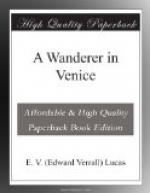CHAPTER XXVIII
GIORGIONE
The Palazzo Giovanelli—A lovely picture—A superb innovator—Pictures for houses—The Tempest—Byron’s criticism—Giorgione and the experts—Vasari’s estimate—Leonardo da Vinci—The Giorgionesque fire—A visit to Castel Franco—The besieging children—The Sacristan—A beautiful altar-piece—Pictures at Padua—Giorgiones still to be discovered.
It will happen now and then that you will be in your gondola, with the afternoon before you, and will not have made up your mind where to go. It is then that I would have you remember the Palazzo Giovanelli. “The Palazzo Giovanelli, Rio di Noale,” say to your gondolier; because this palace is not only open to the public but it contains the most sensuously beautiful picture in Venice—Giorgione’s “Tempest”. Giorgione, as I have said, is the one transcendentally great Venetian painter whom it is impossible, for certain, to find in any public gallery or church in the city of his adoption. There is a romantic scene at the Seminario next the Salute, an altar-piece in S. Rocco, another altar-piece in S. Giovanni Crisostomo, in each of which he may have had a hand. But none of these is Giorgione essential. For the one true work of this wistful beauty-adoring master we must seek the Palazzo Giovanelli.
You can enter the palace either from the water, or on foot at the Salizzada Santa Fosca, No. 2292. A massive custodian greets you and points to a winding stair. This you ascend and are met by a typical Venetian man-servant. Of the palace itself, which has been recently modernized, I have nothing to say. There are both magnificent and pretty rooms in it, and a little boudoir has a quite charming floor, and furniture covered in ivory silk. But everything is in my mind subordinated to the Giorgione: so much so that I have difficulty in writing that word Giovanelli at all. The pen will trace only the letters of the painter’s name: it is to me the Palazzo Giorgione.




